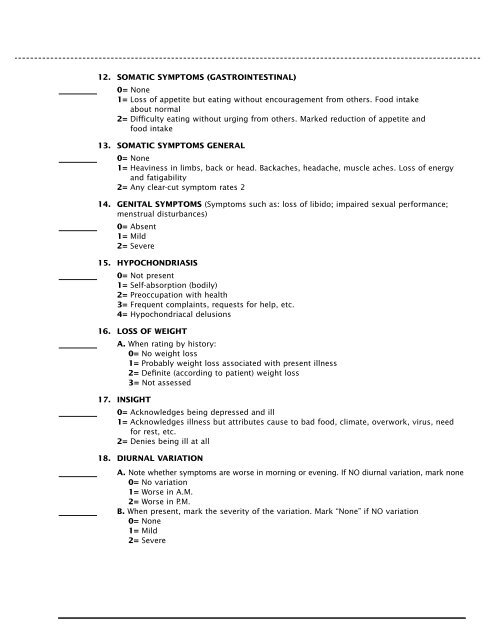Center for Epidemiologic Studies Depression Scale ... - myCME.com
Center for Epidemiologic Studies Depression Scale ... - myCME.com
Center for Epidemiologic Studies Depression Scale ... - myCME.com
Create successful ePaper yourself
Turn your PDF publications into a flip-book with our unique Google optimized e-Paper software.
12. SOMATIC SYMPTOMS (GASTROINTESTINAL)0= None1= Loss of appetite but eating without encouragement from others. Food intakeabout normal2= Difficulty eating without urging from others. Marked reduction of appetite andfood intake13. SOMATIC SYMPTOMS GENERAL0= None1= Heaviness in limbs, back or head. Backaches, headache, muscle aches. Loss of energyand fatigability2= Any clear-cut symptom rates 214. GENITAL SYMPTOMS (Symptoms such as: loss of libido; impaired sexual per<strong>for</strong>mance;menstrual disturbances)0= Absent1= Mild2= Severe15. HYPOCHONDRIASIS0= Not present1= Self-absorption (bodily)2= Preoccupation with health3= Frequent <strong>com</strong>plaints, requests <strong>for</strong> help, etc.4= Hypochondriacal delusions16. LOSS OF WEIGHTA. When rating by history:0= No weight loss1= Probably weight loss associated with present illness2= Definite (according to patient) weight loss3= Not assessed17. INSIGHT0= Acknowledges being depressed and ill1= Acknowledges illness but attributes cause to bad food, climate, overwork, virus, need<strong>for</strong> rest, etc.2= Denies being ill at all18. DIURNAL VARIATIONA. Note whether symptoms are worse in morning or evening. If NO diurnal variation, mark none0= No variation1= Worse in A.M.2= Worse in P.M.B. When present, mark the severity of the variation. Mark “None” if NO variation0= None1= Mild2= Severe
















